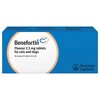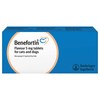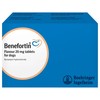Benefortin
Benefortin Flavoured Tablets are for the reduction of proteinuria associated with chronic kidney disease in cats, and for the treatment of congestive heart failure in dogs. They have been made with an extremely palatable recipe and are accepted readily by most pets, whether they are given by mouth or crushed and mixed in with food.
Benefortin Tablets are presented as brownish, oval tablets that have been scored on both sides so that they can be divided into equal halves for easy and accurate dosing.
Benefortin 2.5mg Flavoured Tablets for Dogs and Cats
£0.48Benefortin 2.5mg Flavoured Tablets are indicated for the treatment of congestive heart failure in dogs, and for the reduction of proteinuria associated with chronic kidney disease in cats. ...[More info]
Benefortin 5mg Flavoured Tablets for Dogs and Cats
£0.74Benefortin 5mg Flavoured Tablets are indicated for the treatment of congestive heart failure in dogs, and for the reduction of proteinuria associated with chronic kidney disease in cats. ...[More info]
Benefortin 20mg Flavoured Tablets for Dogs
£1.58Benefortin 20mg Flavoured Tablets are indicated for the treatment of congestive heart failure in dogs. Benefortin is extremely palatable, and even though the tablets are bitter tasting,...[More info]
Dosage and Administration
The veterinary medicinal product should be given orally once daily, with or without food. The duration of treatment is unlimited. The tablets are flavoured and are taken voluntarily by most dogs and cats.
Cats: Tablets should be administered orally at a minimum dose of 0.5 mg (range 0.5 - 1.0) benazepril hydrochloride/kg body weight once daily
Dogs: Tablets should be administered orally at a minimum dose of 0.25 mg (range 0.25-0.5) benazepril hydrochloride/kg body weight once daily, according to the following table. The dose may be doubled, still administered once daily, to a minimum dose of 0.5 mg/kg (range 0.5-1.0), if judged clinically necessary and advised by the veterinary surgeon
Contra-Indications, Warnings, etc
Do not use in cases of hypersensitivity to the active substance or to any of the excipients.
Do not use in cases of hypotension, hypovolaemia, hyponatraemia, or acute renal failure.
Do not use in cases of cardiac output failure due to aortic or pulmonary stenosis. Do not use during pregnancy or lactation.
Special Precautions For Use in Animals
No evidence of renal toxicity of the veterinary medicinal product has been observed (in dogs or cats) during clinical trials, however, as is routine in cases of chronic kidney disease, it is recommended to monitor plasma creatinine, urea and erythrocyte counts during therapy. The efficacy and safety of benazepril has not been established in dogs and cats below 2.5 kg body weight. The chewable tablets are flavoured. In order to avoid any accidental ingestion, store tablets out of reach of the animals.
In double-blind clinical trials in dogs with congestive heart failure, benazepril was well tolerated with an incidence of adverse reactions lower than observed in placebo treated dogs.
A small number of dogs may exhibit transient vomiting, incoordination, or signs of fatigue. In cats and dogs with chronic kidney disease, benazepril may increase plasma creatinine concentrations at the start of therapy. A moderate increase in plasma creatinine concentrations following administration of ACE inhibitors is compatible with the reduction in glomerular hypertension induced by these agents, and is therefore not necessarily a reason to stop therapy in the absence of other signs.
Benazepril may increase food consumption and body weight in cats. Emesis, anorexia, dehydration, lethargy, and diarrhoea have been reported in rare occasions in cats.
Do not use during pregnancy or lactation. The safety of benazepril hydrochloride has not been established in breeding, pregnant or lactating dogs and cats. Benazepril reduced ovary/oviduct weights in cats when administered daily at 10 mg/kg body weight for 52 weeks. Embryotoxic effects (foetal urinary tract malformation) were seen in trials with laboratory animals (rats) at maternally non-toxic doses.
In dogs with congestive heart failure, benazepril hydrochloride has been given in combination with digoxin, diuretics, pimobendan and anti-arrhythmic veterinary medicinal products without demonstrable adverse interactions.
In humans, the combination of ACE inhibitors and Non-Steroidal Anti-Inflammatory Drugs (NSAIDs) can lead to reduced anti-hypertensive efficacy or impaired renal function. The combination of benazepril hydrochloride and other anti-hypertensive agents (e.g. calcium channel blockers, β-blockers, or diuretics), anaesthetics or sedatives may lead to additive hypotensive effects. Therefore, concurrent use of NSAIDs or other medications with a hypotensive effect should be considered with care. Renal function and signs of hypotension (lethargy, weakness etc.) should be monitored closely and treated as necessary. Interactions with potassium-preserving diuretics like spironolactone, triamterene or amiloride cannot be ruled out. It is recommended to monitor plasma potassium levels when using benazepril in combination with a potassium sparing diuretic because of the risk of hyperkalaemia.
Benazepril reduced erythrocyte counts in normal cats when dosed at 10 mg/kg body weight once daily for 12 months and in normal dogs when dosed at 150 mg/kg body weight once daily for 12 months, but this effect was not observed at the recommended dose during clinical trials in cats or dogs.
Transient reversible hypotension may occur in cases of accidental overdose. Therapy should consist of intravenous infusion of warm isotonic saline.
Special Precautions to be Taken by the Person Administering the Veterinary Medicinal Product to Animals
Wash hands after use. In case of accidental oral ingestion, seek medical advice immediately and show the label or the package leaflet to the physician. Pregnant women should take special care to avoid accidental oral exposure because angiotensin converting enzyme (ACE) inhibitors have been found to affect the unborn child during pregnancy in humans.


